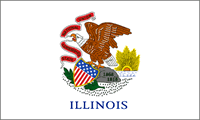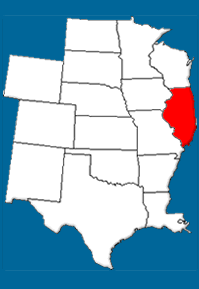 History:
French explorers and missionaries were among the first Europeans to come to Illinois. Jacques Marquette and Louis Jolliet entered the region in 1673 from the French Canadian colonies to the north. They were sent by the governor of their colony to find and trace the Mississippi River. The two men traveled south along the western boundary of Illinois, then northward up the Illinois River. Two years later, Marquette returned to establish a mission at the Kaskaskia Indian village near present-day Utica.
In 1699, French priests established Cahokia, the first permanent town in the region. Cahokia was a fur-trading post. The fur trade was commercially very important to Illinois during the late 17th century. Furs were taken down the Chicago River to Lake Michigan, loaded on awaiting ships, and taken to Europe for sale. Cahokia, along with the town of Kaskaskia, established by Jesuit priests in 1703, became the center of life for French settlers in the area.
Illinois became part of the French colony of Louisiana in 1717. Soon many French settlers began arriving from Europe. Unrest quickly developed between the French and the British, who had claimed all territory inland from their Atlantic colonies. The French joined with the Indians in a series of conflicts with the British known as the French and Indian Wars (1754-1763). The British were ultimately successful and France gave up its claim to Illinois in 1763 as a result of the Treaty of Paris. Many French settlers left the region, moving west, across the Mississippi River.
In 1778, during the American Revolution (1775-1783), Colonel George Rogers Clark of Virginia captured the towns of Kaskaskia and Cahokia. This region became part of Virginia. After the war ended, the state of Maryland refused to ratify the Articles of Confederation until Virginia and other states gave up their western lands. So in 1784, Virginia gave this territory to the government.
Illinois became part of the Northwest Territory in 1787 and, through an act of Congress, part of Indiana Territory in 1800. In 1809, Congress created Illinois Territory, which also included Wisconsin. Kaskaskia became the territorial capital.
As the number of settlers coming to the area increased, more and more land was seized from the native tribes. This created a great deal of anger toward the white settlers. When the United States declared war on Great Britain in 1812, the native tribes sided with the British. A bloody Indian attack occurred in 1812 when the Potawatomis massacred many Illinois settlers at Fort Dearborn.
Illinois became the 21st state in 1818, and in 1820 the capital was moved to Vandalia. At that time, the northern boundary of Illinois only extended as far as the southern tip of Lake Michigan. Nathaneal Pope, a territorial delegate to Congress, successfully extended the boundary northward, to include the present-day Chicago area.
Immigrants from all parts of Europe began arriving in Illinois in the years before the Civil War. The Irish came to work on the Illinois and Michigan Canal. Many others set up farms, built railroads connecting many of the state's major cities, and worked in the growing factories and mines. The capital was moved to Springfield in 1839. The Illinois-Michigan Canal was finished in 1849. It allowed Illinois farmers to easily ship their produce to the East, via the Great Lakes.
The career of Abraham Lincoln, one of the state's most beloved residents, began during a period of tremendous industrial growth and development in the 1840s and 1850s. Lincoln and lawyer Stephen Douglas achieved national attention with their senatorial debates on the slavery issue in 1858. Lincoln became the 16th president in 1861.
Although a strong pro-slavery sentiment existed in the southern part of Illinois, more than 255,000 Illinois soldiers fought for the Union during the Civil War (1861-1865). But no Civil War battles were fought within the state of Illinois.
Industry expanded dramatically after the Civil War. The state legislature began to set aside land for the eventual development of stockyards and the legendary Illinois meat packing industry. By the 1870s, building construction could not keep pace with the growing city of Chicago. Many flimsy, wooden structures had been hastily built to accommodate the increasing population. A tragic fire in 1871 destroyed most of the city and left 100,000 people homeless.
Between 1870 and 1900, workers in the state's factories, railroads and mines began to protest unfair labor practices. This resulted in a series of violent disputes that included the Haymarket Square Riot in 1886 and the Pullman Strike in 1894. |









